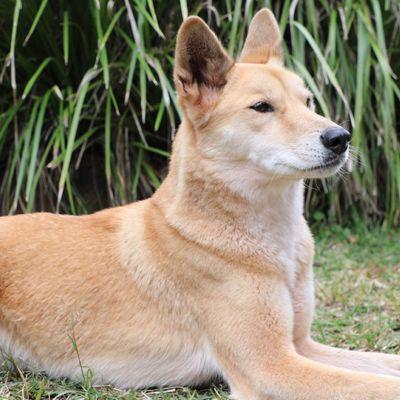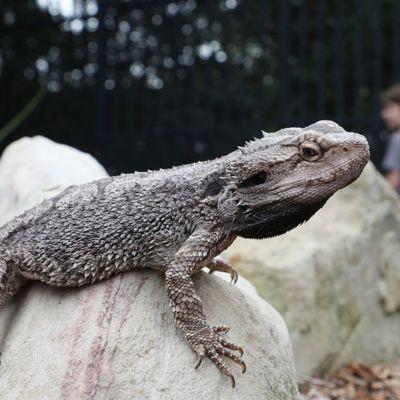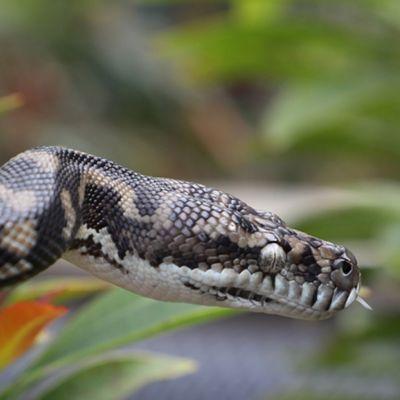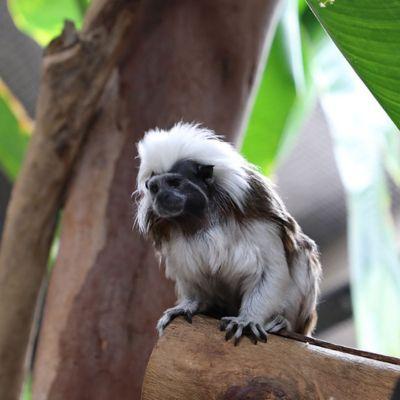Animals at the Zoo
Quoll
There are six species of quoll, four of which are found throughout Australia including the:
- Spotted-tailed quoll
- Western quoll
- Eastern quoll
- Northern quoll
The remaining two species, the Bronze Quoll and the New Guinean Quoll are found in New Guinea.
The Spotted-tailed Quoll, Dasyurus maculatus, is the largest of Australia's quoll species and are considered an apex (top) predator. This elusive, carnivorous marsupial is native to the east coast of Australia through to Tasmania and can be found in our local area.
Keeper talk
Discover more about quolls through our keeper talk. This talk is also combined with our Cotton-top Tamarin talk. Keeper talks are free, suitable for children and everyone is welcome to attend. No bookings are required. Meet the keeper in front of the animal exhibit.
Talks start at 10.35am in front of the quoll exhibit and are run on a Tuesday, Wednesday, Friday, Saturday and Sunday outside of the school holidays. Keeper talks are also run during the school holidays.
Saving the Spotted-tailed Quoll
You can find out more about the Spotted-tailed Quoll and how you can do your part to save them through the Wildlife Queensland's Quoll Seekers Network Guide, or by chatting to one of our zookeepers.
Saving the Spotted-tailed Quoll A Landholder's Guide
Did you know?
When spotted-tail quolls are born they are the size of a grain of rice. Once they are adults, they can weigh between 2kg - 7kg with males weighing more than females.
Dingoes

Australia's largest terrestrial, or land based carnivore, the dingo (Canis lupus dingo) have been at Alexandra Park Zoo since 2013.
This species can be found in a wide variety of habitats, including deserts, grasslands, rainforests and alpine areas across mainland Australia, except for Tasmania where they have never been recorded.
Dingoes are opportunistic hunters, as well as scavengers, consuming a wide variety of food such as kangaroos, wallabies, small mammals, birds, reptiles and feral animals such as pigs and rabbits.
Breeding occurs once a year from March to June with litters around 6 - 10 pups.
In the wild dingoes can typically live for 7 - 10 years, while domestic dingoes can live for a further six years.
Did you know?
Dingoes rarely bark but howl like a wolf.
Lizards

Land Mullet
Why does this lizard have such a fishy name? If you look closely its body is covered in smooth black fishlike scales and it has a fishlike head. The land mullet, Egernia major is the largest member of the skink family.
Eastern Bearded Dragon
These interesting lizards Pogona barbata communicate to each other by bobbing their heads and bodies and waving their forearms. These animals get their name from the skin under their throat that inflates into a beardlike shape when alarmed.
Freckled Monitor
The bodies of these lizards, Varanus tristis are covered in rows of eye shaped circles. These small lizards grow up to a lenght of 80cm and are fast hunters chasing down small snakes, lizards and insects.
Lace Monitors
Lace Monitors, Varanus varius are the second largest lizard in Australia and belong to the only group that have a forked tongue like snakes.
Lizards Love Life at the Zoo
Lizards Love Life at Alexandra Park Zoo
Did you know?
When threatened, the Land Mullet releases a strong fishy odour!
Snakes

Brown Tree Snake
As their name suggests, brown tree snakes, Boiga irregularis are skilled tree climbers where they search for lizards, birds and small mammals. These rear fanged snakes are considered mildly venomous. They are mostly active at night, which, along with their banded body has also earned them the name Night Tigers.
Coastal Carpet Python
One of the widest and most commonly distributed python species in Australia, coastal carpet pythons, Morelia spilota snakes can grow up to 3 metres and live in excess of 100 years! These powerful snakes are non-venomous but use their 80 backward facing teeth to catch possums, birds and snakes and then constrict them suffocating their prey.
Did you know?
The eyes of snakes go milky just before they shed their skin.
Freshwater turtles

The white throated snapping turtle, Elseya albagula is one of Australia’s largest short-necked freshwater turtles, with females growing to a shell length of around 40 cm.
This critically endangered species is only found in the Burnett, Fitzroy, and Mary River systems of Central Queensland.
What's the difference between males and females?
While both male and female turtles have a large robust head, it is only the female that has irregular white or cream markings on the sides and under surfaces of the head and neck.
"Bum-breathers"
These herbivorous turtles have the ability to absorb oxygen directly from the water through special structures inside their cloaca, giving them the term ‘bum breathers’ allowing them to stay under water for up to 3 hours. As these turtles rely on this aquatic respiration for up to 74% of their oxygen requirements, they are heavily affected by degradation and modification of their river systems. This, along with egg predation by feral and native animals, trampling of nests and eggs by livestock are the leading causes for their rapid decline.
Come and see if you can spot our adult male and juvenile White-throated Snapping Turtles and Krefft's Turtle, Emydura krefftii, swimming in their ponds.
Alby's eccentric hair impresses zoo visitors
Did you know?
White-throated snapping turtles can dive for up to three hours!
Cotton-Top Tamarins

Cotton-top Tamarins, Saguinus Oedipus, are critically endangered in their native home of north-western Colombia, South America, due to deforestation and the illegal pet trade.
This species of monkey is recognisable from their head of hair which looks a bit like a ball of cotton.
They are omnivores so will often be seen eating fruit and vegetables as well as a variety of protein items.
Cotton-top Tamarins live in complex troops where there is a bonded dominant breeding pair with submissive helpers which help to care for offspring; only the dominant pair will breed as the submissive female’s reproduction is supressed.
They are a canopy dwelling species therefore they have claws for climbing and a long tail for balance, come in person and see our Tamarins use these features to move around!
Keeper Talks
Learn about these endangered species through our keeper talk and watch them being fed! This talk is also combined with our quoll talk.
Talks start at 10.35am in front of the Cotton-top Tamarin exhibit and are run on a Wednesday, Friday, Saturday and Sunday outside of school holidays.
During school holidays check the zookeeper talk schedule for more dates and times.
Australasian Species Management Program
Alexandra Park Zoo is proud to be part of the Australasian Species Management Program (ASMP) to raise awareness of this highly social primate species.
"Monkey Park"
Alexandra Park Zoo is often affectionately referred to as the "Monkey Park" following popular primate exhibits over the years, starting with the first monkey transported from Melbourne Zoo in 1912 via the ship Tinana.
New arrival
In 2023 following the passing of Solita, the region's oldest surviving Cotton-top Tamarin at age 24 years and 8 months, Alexandra Park Zoo welcomed Philippe, a four-year old Cotton-top Tamarin from the National Zoo and Aquarium in Canberra who has become a companion and possible breeding partner for Solita's daughter Turbo. Watch Philippe's arrival at Alexandra Park Zoo.
Did you know?
When Cotton-Top Tamarins become alarmed or excited their white fur stands up to make them look more impressive!
Read more about the Zoo's conservation efforts surrounding these species here.
Australian Parrots

Alexandra Park Zoo is home to five species of Australian Parrots.
Red-tailed Black Cockatoos
The Red-tailed Black Cockatoo, Calyptorhynchus banksia, are also known as the Banksian or Banks' Black Cockatoo. There are 5 recognised sub-species that mostly differ in the size of their beak. They are commonly found in eucalypt woodlands and like to nest within large tree hollows, feeding on mostly seeds, fruit, berries and nectar. The average height for this species is 60cm, they weigh between 600-920g and have a top flight speed of 70km/h!
King parrots
Our aviaries also include King Parrots, Alisterus scapularis, which are the only Australian parrots where the males have a completely red head. These beautiful birds were first described by the German naturalist Martin Lichtenstein in 1818.
Red-winged Parrots
Red-winged Parrots, Aprosmictus erythropterus, are named for their bright red shoulder patches. During courtship the male circles the female, lowers his wings to expose the blue patch on his lower back and holds his wings close to his body. As well as feeding on seeds, nectar, pollen and blossoms these parrots also eat insects and larvae.
Princess Parrots
Princess Parrots, Polytelis alexandrae, were named after Princess Alexandra of Denmark. You can determine the male and female bird by looking at their eye colour. Males have orange irises while females have brown irises.
Sulphur-crested Cockatoos
The Sulphur-crested Cockatoo, Cacatua galerita, is a widely spread species of cockatoo found in wooded areas throughout Australia as well as New Guinea and some of the Indonesian Islands. They are a highly intelligent bird that can live from 40 to 100 years and are truly monogamous (they may sometimes pair for life). They are often seen in large flocks and are recognisable for their distinctive loud screeching sounds.
To attract parrots to your own garden, plant native species that produce seed or nectar and provide water at a height that keeps them safe from cats.
Did you know?
Parrots have four toes on each foot like most birds, but, instead of three toes in front and a single toe behind, parrots are zygodactyl, meaning they have two toes in front and two toes behind.
Frogs

The zoo became home to green tree frogs, Pelodryas caeruleus, in March 2021.
The zoo team have designed their home to reflect the place where many people see this species of native frog - their backyard. Water tanks, drain pipes, toilets and letterboxes are also popular frog spots in urban areas. In the wild you will find them in cool, damp dark places including wetlands, forests, woodlands and heath.
What do they look like?
These frogs have smooth green skin with scattered white spots on their back and creamy white underbellies. Their skin has a waxy coating to help reduce evaporation.
Tiny sticky pads on their toes help them climb smooth surfaces allowing them to escape predators and find food such as insects, spiders, worms, lizards and other frogs.
Predators and disease
Natural predators of Green Tree Frogs are snakes and birds, but the main danger threat to this species is the destruction of habitat and a disease called chytrid fungus that attacks the frogs skin.
Where do they live in Australia?
You will find these large amphibians in all states except for Victoria and Tasmania.
Importance
Frogs are important indicator species meaning they are sensitive to changes in their environment. If frogs are no longer seen in an area it may indicate a change in the quality of air or water.
Be Frog Friendly
- Create a frog pond to provide breeding habitat
- Keep chemicals away from your pond or areas where frog live
- Frogscape your yard with plants, rocks, logs and ground cover
- Create a frog hotel
- Keep your cats and dogs indoors. It’s estimated that 1 million frogs are killed by pet cats each year across Australia. This figure increases to almost 100 million if frogs killed by feral cats are included.
- If you have a large property, retain areas of native vegetation as the rocks, leaf litter and fallen timbers may be vital refuge sites.
- Maintain wildlife corridors, and preserve natural waterways on your property.
- Keep cattle and other hard-hooved livestock away from sections of stream banks and dams by fencing off portions of the bank.
Did you know?
A group of frogs is called an army, while a group of toads is called a knot.
Wallabies

Swamp Wallaby
Swamp wallabies, Wallabia bicolour are different from all other wallabies due to their unique teeth and lower number of chromosomes. They have a very broad premolar which is used to help them eat very coarse plant material. These animals have a very different hop to kangaroos, keeping their head down and tail straight out instead of keeping their head up.
Parma Wallaby
Parma wallabies, Macropus parma are the smallest of the kangaroo, wallaby and wallaroo species. They were discovered in 1840, but due to their shy nature they were thought to be extinct.
Red-necked wallaby
Red-necked wallabies are named due to their rusty-red shoulders and upper back. They also have a white stripe on their upper lip and a black nose and paws. These wallabies can be found in coastal scrub and sclerophyll forest (vegetation with hard leathery evergreen leaves) throughout coastal and highland eastern Australia from Bundaberg, Queensland to the South Australian border, in Tasmania and on many of the Bass Strait islands.
These animals are medium sized, standing approximately 1 metre in height, with males being larger in size than females. This species can live up to 15 years in the wild and in captivity. Red-necked wallabies are listed as ‘least concern’ as a species as they are considered common in the wild.
The term ‘macropus’, from the red-necked wallaby’s scientific name Macropus rufogriseus, comes from the Greek word ‘makros’ meaning ‘long foot. Long, narrow hind feet are a distinguishing feature of wallabies, kangaroos, and wallaroos.
Embryonic diapause
Did you know that all macropods can pause a pregnancy, meaning that the embryo remains dormant and is not implanted into the uterus? This reproductive strategy is known as embryonic diapause. This occurs when a female macropod is feeding a young joey and falls pregnant or when a female macropod falls pregnant but environmental conditions are not favourable (lack of food, cold weather). Delaying the development of the embryo in these circumstances can help to improve the survival rate of the offspring.
Did you know?
Kangaroos and wallabies are good swimmers and use their tails to help them swim.
Emus

Emus, (Dromaius novaehollandiae), are an Australian native species of flightless bird and are the second largest living bird in the world, standing over 1.5 metres and weighing in excess of 45kg.
This species can be found throughout mainland Australia in a vast range of habitats, but most commonly in open plains.
Although this bird species cannot fly, they make up for it by being able to trot for long distances and maxing out at speeds of around 50km/hour.
If they are unable to run away from predators, they have a very impressive kick paired with large nails which can do a lot of damage.
Emus also have very beautiful eggs which are a dark green colour; male emus will look after the eggs and any chicks that hatch.
Unfortunately emus were exterminated by early Europeans in Tasmania and are now only found on the mainland of Australia.
Emus Apple and Jimmy a quirky pair at the zoo.
Instead of flying, they have three toes and well developed calf muscles that help them reach running speeds of up to 50kph, with a stride of three metres.
Did you know?
While emu’s don’t fly, they have 20cm long ‘winglets’ hidden under their shaggy plumage which they hold out to stabilise them when they run.
Native bees
Our native Australian bee hive was rescued from being cleared and kindly donated to the zoo by Wide Bay Stingless Bees. The hive is in a native Eucalyptus tree and takes pride of place next to our freshwater turtle exhibit.
What’s happening to the bees?
Native bees are experiencing loss of habitats, feeding and breeding sites so we want to do our bit to help conserve a local native species, especially one that plays such an important role in pollinating our natural environment.
Australia is home to over 1,700 native bee species most of which live by themselves. Eleven of these species are stingless bees who are very social and live together. Stingless bees, as their name suggests, do not have a sting like a honeybee but can bite if they feel threatened.
What species of bee is at the zoo?
The stingless bee species at the zoo are called Austroplebeia australis, a special group of bees endemic to Australia and New Guinea. In Australia, you can find them from the north coast of New South Wales, through Queensland and the Northern Territory, and across to the Kimberly in Western Australia. They are black with a row of four cream marks on their thorax (the area just behind their head) and they don’t like the cold that much, only appearing once the temperature reaches 20 degrees Celsius.
Will the bee's honey be harvested?
Stingless bees are collectively known as sugarbag bees due to their sweet honey. Our bees will produce around 1kg of honey each year depending on seasonal influences. As we don’t want to disturb their hive the zoo will leave the honey to the bees.
How many bees are in the hive?
There are about 5,000 individual bees living in our hive. There is one queen, some drones (male bees) and thousands of female worker bees.
How far do the bees fly, and where do they live in the wild?
At only 4mm long and weighing as much as a grain of sand, our native stingless bees might be small but they can fly up to 500 metres from their hive in search of nectar, pollen or plant resin.
In the wild, native bee hives can typically be found in tree hollows, however they are commonly found in water meters and telephone pits in urban areas.
Read more about our bees here.
When you come to visit we hope that you enjoy watching the bees as much as we do, get inspired to plant some bee friendly plants in your garden and learn more about these amazing insects.
Did you know?
Native bees have a weak electrostatic charge on their bodies to attract pollen to their bodies, but don't worry it's not strong enough to hurt you.
